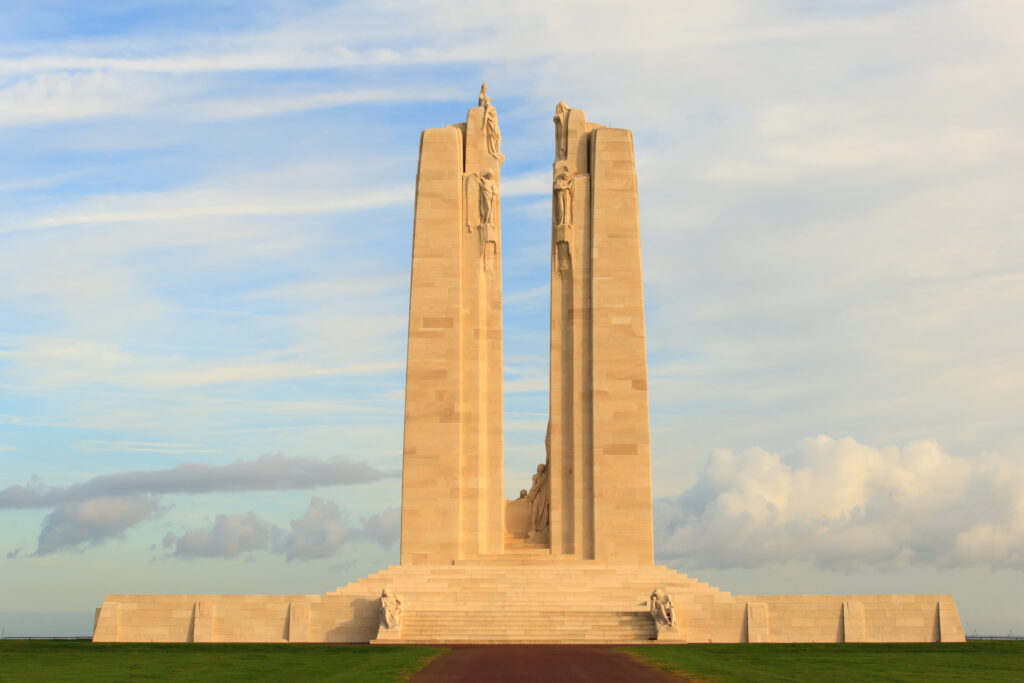
Day 1
Transfer from Paris to Beaumont Hamel, Thiepval and Vimy, Stay over in Ypres
Canada was a member of the British Empire during World War I and made a significant contribution to the Allied war effort. Over 600,000 Canadians enlisted in the military during the war, and more than 66,000 of them lost their lives. Canadian soldiers played a key role in several major battles, including the Battle of Vimy Ridge and the Battle of Passchendaele. In addition to providing troops, Canada also contributed financially to the war effort and provided a significant amount of food and other resources to the Allied powers. Overall, Canada’s involvement in World War I was an important part of the country’s history and helped establish its reputation as a major player on the international stage.
The Beaumont-Hamel Newfoundland Memorial is a memorial dedicated to the memory of the soldiers of the Newfoundland Regiment who lost their lives during the Battle of the Somme in World War I. The memorial is a poignant reminder of the sacrifices made by the soldiers of Newfoundland and is an important part of the region’s World War I history.
After a stop at Thiepval Memorial, you will carry on the day at Vimy Ridge located near the town of Arras. It is dedicated to the memory of the Canadian soldiers who lost their lives during the Battle of Vimy Ridge. The memorial features two towering pylons, which are inscribed with the names of the 11,285 Canadian soldiers. It is a symbol of Canada’s sacrifice and bravery during World War I and is an important part of the country’s national heritage.
You will drive to Ypres to stay overnight and attend the last post ceremony.
Day 2
Day tour in Ypres, Passendale and stay over in Ypres
Ypres is a town located in Flanders. It was the site of several major battles during World War I, in which Canadian forces played a significant role. The Canadian Corps was involved in several key engagements, including the Second Battle of Ypres, where they successfully defended the town against a German gas attack. The Canadian contribution to the defense of Ypres was instrumental in preventing the Germans from breaking through the Allied lines and advancing further into Belgium. Today, Ypres is home to several war memorials and cemeteries, including the Menin Gate, which commemorates the soldiers of the British and has the names of more than 54,000 soldiers who have no known grave.
A day tour of the Ypres Salient for Canadians will include the following stops:
Begin the tour at the Brooding Soldier memorial at Vancouver Corner, which marks the site of the gallant defensive actions of the First Canadian Division during the Second Battle of Ypres. Learn about the Canadian soldiers’ defense against the first-ever use of chlorine gas by the Germans and their steadfastness in the face of adversity.
Continue on to Hill 60 to discuss underground warfare and the involvement of Canadian miners who worked below the surface in some of the most dangerous conditions of the war. Take advantage of the visible craters to learn more about this aspect of the war.
After lunch, focus on the Third Battle of Ypres and visit the Passchendaele ridge, where you can see the landscape that resembled a vast sea of mud during the battle. Learn about the suffering and death that took place here and hear stories of the men who fought in this terrible battle.
During the day, we will visit a variety of local military cemeteries, including Tyne Cot Cemetery, the largest Commonwealth War Graves Commission cemetery in the world and Essex farm Cemetery where John McCrae the author of the famous poem “in Flanders field” is resting.
At the end of the day, you will have a greater appreciation of Canadian efforts in the Ypres salient and the sacrifices made during World War I.
Day 3
Drive along the coast by Dunkirk and Calais toward Dieppe. Stay over in Dieppe
The Canadians played a significant role in the Dieppe Raid, also known as the Battle of Dieppe, which took place on the coast of France during World War II. The raid was an Allied attempt to test German defenses and gather intelligence, but it was ultimately a failure, resulting in heavy casualties. Of the nearly 5,000 Canadians who participated in the raid, more than 900 were killed, over 1,000 were wounded, and nearly 2,000 were taken prisoner. Despite the high cost of the raid, the Canadians who took part in the Battle of Dieppe are remembered for their bravery and sacrifice. Today, there are several memorials in Dieppe and the surrounding area to honor the Canadians who lost their lives in the raid. Spending a day touring around the different sites of the operation will be a poignant reminder of the sacrifices made by the soldiers.
Day 4
Drive toward the Normandy Battlefield stopping in Honfleur. Half day on the highlights of DDAY. Stay over in Bayeux
After some time spent on Omaha Beach, you will discover the American Cemetery inaugurated in 1956 and run by the American Battle Monuments Commission. This is the place to go if you want to pay a tribute to the American soldiers who died during the battle of Normandy.
The tour also includes a visit to Pointe du Hoc where James Rudder’s Rangers climbed a cliff under heavy fire to knock out a German coastal battery. This site is maintained as a WW2 battlefield where you can still observe bunkers and hundreds of bomb craters.
Day 5
Canadian dday guided tour. Stay over in Bayeux
During this day, discover the fate of the 3rd Canadian Division spearheading the invasion. The tour starts at Saint Aubin sur Mer where the NewBrunswick landed. Wrong intelligence turned their landing into a bloodbath. Your guide will show you Bernière Sur Mer . the Queens own rifles landed in front of this village. At the end of the day Bernière was the sector where the Canadians got their heaviest casualties. You will then reach Courseulles sur mer the most heavily defended part of Juno sector. Many men from The Regina rifles and the Winnipeg paid the ultimate price to pave the way for their brothers. Your tour includes the visit of the Juno center. This unique museum describes the history of Canada through the war. A must-do for any Canadian in Normandy. Your guide will lead you to the Bény Cemetery, the resting place of over 2,000 Canadian soldiers. Discover the stories of these men in this humbling place. The tour continues to Tailleville, a small village behind Juno beach. The Germans had fortified the village for months before the invasion. The battle ended after hours of close quarter combat. Then we will drive to hell’s corner a place where the Canadian’s 3rd Division stopped at the end of the day. Discover the sad story of 20 young Canadians executed by SS troops at the Abbaye d’Ardenne. The 12th SS Panzer-Division counter attacked the Canadians on June 7. Discover the stories of the Canadians who fought for survival. The tour ends at Bretteville l’orgueilleuse, a village attacked by the SS. The attack was repelled after hard fighting.
Day 6
Mont Saint Michel. Stay over in Saint Malo
Mont Saint Michel is one of the most visited sites in France. The decision was made by Bishop Aubert from Avranches who created the first sanctuary around 708.
Few decades later, it became a major pilgrimage site. Thanks to the work of the religious community on the Mont, the site was seen as an intellectual reference in Europe where numerous books, manuscripts and charters were written or copied.
In the 19th century, the importance of Mont Saint Michel was in decline and it became a prison after the French Revolution in 1789. From 1793 until 1863, the site had the worst reputation. The building suffered from the lack of maintenance during that time and almost disappeared after the French stopped using it as a prison. Fortunately, it was saved from destruction and many architects renovated it from them until the present day.
Discover 13 centuries of history with our experienced guides. On the list of UNESCO World Heritage Sites since 1979, Mont-Saint-Michel is an incredible master-piece of architecture surrounded by the beautiful seascape of one of the largest bays in Europe.
Day 7
Saint Malo and Transfer back to Paris
Saint-Malo and Canada have a historical connection through the French explorer Jacques Cartier, who was born in Saint-Malo and is credited with discovering Canada. Cartier made three voyages to the New World in the 16th century, during which he explored the St. Laurent River and claimed the land for France.
Visiting this historic walled city known for its sandy beaches and charming cobbled streets is a must. You will explore the city’s rich history, walk around and try some of the local specialties, such as buckwheat crepes and cider.
In the afternoon, you will drive back toward Paris.



